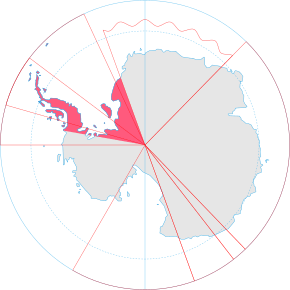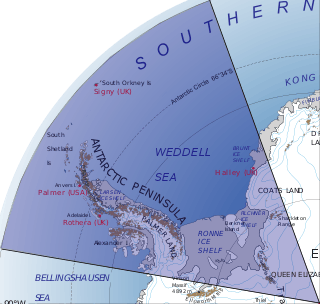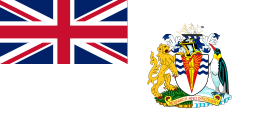British Antarctic Territory
The British Antarctic Territory (BAT) is a sector of Antarctica claimed by the United Kingdom as one of its 14 British Overseas Territories, of which it is by far the largest by area. It comprises the region south of 60°S latitude and between longitudes 20°W and 80°W, forming a wedge shape that extends to the South Pole, overlapping the Antarctic claims of Argentina (Argentine Antarctica) and Chile (Chilean Antarctic Territory).
British Antarctic Territory | |
|---|---|
| Motto(s): "Research and Discovery" | |
| Anthem: "God Save the Queen" | |
 Location of the British Antarctic Territory in Antarctica | |
| Sovereign state | United Kingdom |
| Territory claimed | 1908 |
| Main base and administrative centre | Rothera 67°34′06″S 68°07′33″W |
| Official languages | English |
| Government | Dependency under a constitutional monarchy |
• Monarch | Elizabeth II |
| Ben Merrick | |
• Deputy Commissioner | Jane Rumble |
• Administrator | Stuart Doubleday |
| Government of the United Kingdom | |
• Minister | Tariq Ahmad |
| Area | |
• Total | 1,709,400 km2 (660,000 sq mi) |
| Highest elevation | 10,627 ft (3,239 m) |
| Population | |
• Summer estimate | 250[1] |
| Currency | Pound sterling (£) (GBP) |
| Time zone | UTC-03:00 |
| UK postcode | BIQQ 1ZZ |
| Internet TLD | |
The Territory was formed on 3 March 1962, although the UK's claim to this portion of the Antarctic dates back to letters patent of 1908 and 1917. The area now covered by the Territory includes three regions which, before 1962, were administered by the British as separate dependencies of the Falkland Islands: Graham Land, the South Orkney Islands, and the South Shetland Islands. The United Kingdom's claim to the region has been suspended since the Antarctic Treaty came into force in 1961, Article 4 of which states "No acts or activities taking place while the present Treaty is in force shall constitute a basis for asserting, supporting or denying a claim to territorial sovereignty in Antarctica. No new claim, or enlargement of an existing claim, to territorial sovereignty, shall be asserted while the present Treaty is in force." Most countries do not recognise territorial claims in Antarctica.[2] The United Kingdom has ratified the treaty.
In 2012, the southern part of the territory was named Queen Elizabeth Land in honour of Queen Elizabeth II. The territory is inhabited by the staff of research and support stations operated and maintained by the British Antarctic Survey and other organisations, and stations of Argentina, Chile and other countries. There are no native inhabitants.
History
The United Kingdom has had a continuous presence in the far South Atlantic since 1833 when it reasserted sovereignty over the Falkland Islands. In 1908, the UK extended its territorial claim by declaring sovereignty over "South Georgia, the South Orkneys, the South Shetlands, the Sandwich Islands, and Graham's Land, situated in the South Atlantic Ocean and on the Antarctic continent to the south of the 50th parallel of south latitude, and lying between the 20th and the 80th degrees of west longitude".[3] All these territories were administered as Falkland Islands Dependencies from Stanley by the Governor of the Falkland Islands.
In 1917, the wording of the claim was modified, so as to, among other things, unambiguously include all the territory in the sector stretching to the South Pole (thus encompassing all of the present-day British Antarctic Territory). The new claim covered "all islands and territories whatsoever between the 20th degree of west longitude and the 50th degree of west longitude which are situated south of the 50th parallel of south latitude; and all islands and territories whatsoever between the 50th degree of west longitude and the 80th degree of west longitude which are situated south of the 58th parallel of south latitude".[3]
The United Kingdom also claimed Victoria Land in 1841 and Enderby Land in 1930. However, all territory between 160°E and 45°E was transferred to Australia in 1933.
In 1943, at the height of World War II, the UK undertook a military operation known as Operation Tabarin to provide reconnaissance and meteorological information in the South Atlantic Ocean. This "secret" wartime project became the civilian Falkland Islands Dependencies Survey and later the British Antarctic Survey (BAS). BAS is responsible for most of the United Kingdom's scientific research in Antarctica. In the 1950s, the Antarctic Treaty was negotiated to demilitarise the region and retain Antarctica – defined as all land and ice shelves south of 60°S latitude – for peaceful research purposes. The treaty was passed in 1961.
Recognition
The Antarctic Treaty, signed by all relevant regional claimants, does not in itself either recognise or dispute any territorial claims, leaving this matter to individual signatories.[2] Most of the world's countries do not recognise any national claims to Antarctica.[4] Australia, France, New Zealand, Norway and the United Kingdom, all of whom have territorial claims on the continent, mutually recognise each other's claims.[5][6] Argentina and Chile dispute the British claim, and make their own counter-claims that overlap both Britain's and each other's (see Argentine Antarctica and Chilean Antarctic Territory).
Geography


Topography
The British Antarctic Territory includes the Antarctic Peninsula, the South Shetland Islands, South Orkney Islands and numerous other offshore islands, the Ronne Ice Shelf (Weddell Sea), parts of Coats Land. A 437,000-square-kilometre (169,000 sq mi) triangle of central Antarctica converging on the South Pole was named Queen Elizabeth Land in December 2012, in honour of the Diamond Jubilee of Elizabeth II.[7][8]
Over 99 per cent of the territory's land surface is covered by a permanent ice sheet, up to about 5,000 metres (16,000 ft) thick.[9] The highest peak was thought to be Mount Jackson, on the Antarctic Peninsula, at 3,184 metres (10,446 ft).[9] However, in 2017 Mount Hope was calculated to be taller at 3,239 metres (10,627 ft).[10]
Administration
 |
|---|
| This article is part of a series on the politics and government of British Antarctic Territory |
|
Government
|
|
Research Stations
|
The British Antarctic Territory is administered by the Foreign and Commonwealth Office (FCO). A Commissioner is appointed and is always the Director of the FCO's Overseas Territories Directorate.
The Territory has a full suite of laws and legal and postal administrations. Given the provisions of the Antarctic Treaty System, the Territory does not enforce its laws on foreign nations who maintain scientific bases within the Territory. It is self-financing, with income from the sale of postage stamps and income tax.
Nationality law
The territory is fully a part of the British Overseas Territories for nationality purposes. It is possible to hold British Overseas Territories citizenship (BOTC) by virtue of a connection with the territory. Additionally, since the relevant provisions of the British Overseas Territories Act 2002 came into force on 21 May 2002, a BOTC connected with the territory would also hold British citizenship.
Although this territory's immigration laws would not allow for naturalisation, a person born in the territory before 1983 would hold BOTC (and British citizenship) on that basis. British citizenship and BOTC would also extend to the first generation born overseas. No people currently fall into this category. While Emilio Palma was born in the Antarctic territories claimed by the UK, he has not claimed British citizenship. Since his parents were both Argentine citizens and he was born at an Argentine base, he was automatically granted Argentine citizenship by the Argentine government. Changes to British nationality law from 1 January 1983 mean that children born in the territory can only gain BOTC and/or British citizenship if his/her father or mother holds BOTC and/or British citizenship or if his/her father or mother is "ordinarily resident" in the territory in compliance with the relevant immigration legislation.[12] This effectively prevents any more children born in Argentine or Chilean bases within the area of the British claim being able to claim BOTC or British citizenship by virtue of being born within the territory.
Research stations
The British Antarctic Survey has two permanently staffed research stations in the Territory:[13][14]
Signy was operated from 1947 until 1996 and now is only staffed in the summer.[15] There are also two summer-only forward operating stations at Fossil Bluff and Sky Blu.
Faraday was maintained until 1996, when it was sold to Ukraine and renamed Akademik Vernadsky Station.[16]
Since 1996, the historic base at Port Lockroy on Goudier Island has been staffed by the UK Antarctic Heritage Trust during the Antarctic summer. Receiving about 10,000 visitors a year, it is one of the most visited sites on the continent. Visitors can tour the museum, buy souvenirs, post mail, and view the large gentoo penguin colony.[17]
Argentine presence in the territory dates to the foundation of the Orcadas Base, South Orkney Islands, in 1903.
A number of other nations maintain bases in the territory, many in the South Shetland Islands.[9]
Postage stamps and coins

Despite the lack of permanent inhabitants, the British Antarctic Territory issues its own postage stamps. While some are actually used by visiting tourists and resident scientists, the bulk are sold overseas to collectors. The first issue came in 1963, an engraved set with 15 values ranging from ½d to one pound, featuring a portrait of Queen Elizabeth overlooking various scenes of human activity in Antarctica. Several additional issues in the 1960s were followed by a decimalisation issue in 1971 produced by overprinting the 1963 stamps.
In 2008–2009, as part of the celebrations of the centenary of the 1908 British territorial claim, the British Antarctic Territory issued its first ever legal-tender coin.[18]
Queen Elizabeth Land
On 18 December 2012, the Foreign & Commonwealth Office announced that the southern part of British Antarctic Territory has been named Queen Elizabeth Land in honour of Queen Elizabeth II in her Diamond Jubilee year. The area, the southern third of the territory, has an area of about 437,000 square kilometres (169,000 sq mi) – almost twice the size of the United Kingdom – and is roughly triangular in shape, with the South Pole at one apex and with the 20°W and 80°W lines of longitude forming the eastern and western boundaries. The northern boundary is formed by the Filchner-Ronne Ice Shelf on the west and by Coats Land on the east.
The name "Queen Elizabeth Land" will be used in future on all British maps, but due to the unique status of Antarctica, it will be up to other countries to recognise the name if they see fit.[19] Argentina, which lays claim to part of the area, criticised the naming.[20]
See also
- Australian Antarctic Territory
- British Arctic Territories – 16th century to 1880 and now Canadian Arctic Archipelago
- Hope Bay incident
- Marie Byrd Land
- Princess Elizabeth Land
- Ross Dependency
- Territorial claims in Antarctica
- Tierra del Fuego
References
- Hendry, Ian; Dickson, Susan (2011). British Overseas Territories Law. Oxford: Hart Publishing. p. 299. ISBN 9781849460194.
- "The Antarctic Treaty". National Science Foundation, Office of Polar Programs. Archived from the original on 19 May 2019.
- Casarini, Maria Pia (1996). "Activities in Antarctica Before the Conclusion of the Antarctic Treaty". In Francioni, Francesco; Scovazzi, Tullio (eds.). International Law for Antarctica (Second ed.). Kluwer Law International. p. 652. ISBN 90-411-0364-3. LCCN 96054217.
- "The World Factbook — Central Intelligence Agency". Retrieved 19 March 2017.
- Headland, Robert K. (1989). Chronological List of Antarctic Expeditions and Related Historical Events. Cambridge University Press. ISBN 0-521-30903-4. LCCN 88037622. Retrieved 13 August 2012.
- Cahoon, Ben. "British Antarctic Territory". Worldstatesmen.org. Retrieved 13 August 2012.
- "UK to rename part of Antarctica Queen Elizabeth Land". BBC News. 18 December 2012. Archived from the original on 15 April 2014. Retrieved 18 December 2012.
- Rayner, Gordon (18 December 2012). "Part of Antarctica named 'Queen Elizabeth Land' as gift for Diamond Jubilee". The Telegraph. Archived from the original on 25 September 2015. Retrieved 18 December 2012.
- British Antarctic Territory, Country Facts Archived 12 March 2011 at the Wayback Machine, Foreign & Commonwealth Office
- New satellite imagery reveals new highest Antarctic Peninsula Mountain British Antarctic Survey, 11 December 2017
- Commonwealth Secretariat Website Archived 5 June 2011 at the Wayback Machine
- British Nationality Act 1981, s.1, s.15 & s.50
- "Research Stations in Antarctica". British Antarctic Survey. Retrieved 7 September 2008.
- Extreme Engineering: the challenges of working in Antarctica Archived 2 October 2011 at the Wayback Machine, Ingenia, September 2005.
- "Signy Research Station". British Antarctic Survey. Archived from the original on 3 March 2011. Retrieved 7 September 2008.
- "Faraday Station - History". British Antarctic Survey. Retrieved 7 September 2008.
- "Port Lockroy". UK Antarctic Heritage Trust. Archived from the original on 21 May 2008. Retrieved 7 September 2008.
- "The British Antarctic Territory Currency". United Kingdom Antarctic Heritage Trust. Archived from the original on 19 April 2010.
- "The Foreign Secretary has announced that the southern part of British Antarctic Territory has been named Queen Elizabeth Land". Foreign & Commonwealth Office. 18 December 2012. Archived from the original on 7 July 2013. Retrieved 18 December 2012.
- "Argentina angry after Antarctic territory named after Queen". BBC News. 22 December 2012. Archived from the original on 15 January 2013. Retrieved 22 December 2012.
External links
| Wikimedia Commons has media related to British Antarctic Territory. |
- British Antarctic Territory at UK Foreign Office
- British Antarctic Survey


.svg.png)